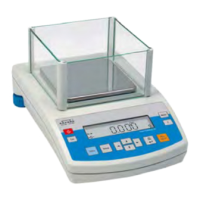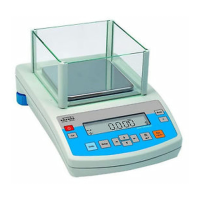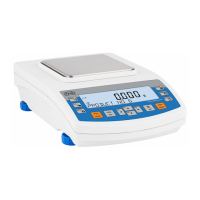
Do you have a question about the RADWAG PS 600.R2 and is the answer not in the manual?
| Maximum Capacity | 600 g |
|---|---|
| Readability | 0.01 g |
| Power Supply | AC 230 V |
| Repeatability | ± 0.01 g |
| Linearity | ± 0.02 g |
| Stabilization Time | 2 s |
| Operating Temperature | +10° - +40° C |
| Protection Class | IP 43 |
| Display | LCD |
| Calibration | External |
| Interface | RS-232 |
Details the available connection ports on the balance.
Describes the features and specifications of the PS R2.H series balances.
Explains the proper application and use of the balance.
Lists actions that should not be performed with the balance.
Outlines the conditions under which the warranty is invalidated.
Discusses the periodic inspection of the balance's metrological characteristics.
Advises users to read the manual before assembly and start-up.
Emphasizes the need for trained personnel to operate the balance.
Instructs users to check for external damage upon delivery.
Provides guidelines for retaining original packaging for future transport.
Details requirements for balance installation and operating environment.
Provides step-by-step instructions for removing the balance from its packaging.
Explains the procedure for leveling the balance using adjustable feet.
Provides instructions and precautions for cleaning the balance.
Details the procedure for connecting the balance to the power supply.
Guides on connecting peripherals like printers and computers.
Instructions for connecting external devices like printers or computers.
Explains the necessary waiting time for balance thermal stabilization.
Describes how to navigate the balance's user menu using keyboard buttons.
Outlines essential procedures for proper weighing.
Explains how to set the balance to zero before weighing.
Details the process of taring the balance for net weight determination.
Configures parameters specific to the weighing mode.
Enables automatic taring of packaging during weighing.
Sets the balance's printing mode for measurement results.
Allows temporary selection of a different measuring unit.
Sets the default measuring unit used upon balance start-up.
Declares which measuring units will be available for selection.
Allows defining custom weighing units based on a factor.
Displays additional information in the bottom line of the display.
Allows declaring custom text to be displayed in the bottom line.
Assigns quick access functions to the F1-F4 buttons.
Details operation of the dual range weighing instrument.
Allows selection of the balance menu language.
Manages user access levels for balance functions.
Controls audible feedback for button presses.
Adjusts display brightness and backlight settings.
Allows setting the current date.
Allows setting the current time.
Sets the date format for printouts.
Sets the time format for printouts.
Performs an automated self-test of the balance.
Performs automatic internal calibration of the balance.
Configures various balance adjustment settings.
Allows manual adjustment using external weights or internal calibration.
Prints a report of the balance adjustment process.
Configures data included in the adjustment report.
Configures data included in the header printout.
Configures data for GLP compliant measurement result printouts.
Configures data included in the footer printout.
Allows defining custom printout formats.
Manages user accounts, access levels, and language settings.
Manages product entries including name, code, mass, and thresholds.
Stores tare values for packaging, including name and mass.
Automatically saves measurement data, including date, result, and user.
Stores up to 100,000 measurements in a separate memory.
Allows archiving and copying of balance databases to external media.
Enables transferring saved data into a new balance.
Saves measurement data to an external memory device.
Allows users to enable or disable specific balance working modes.
Enables counting small objects of identical mass.
Checks if sample mass falls within predefined low and high thresholds.
Weighs samples until a target mass is reached with tolerance.
Calculates percentage deviation of samples from a reference mass.
Determines the mass of objects in motion with specialized filtering.
Determines the density of solid materials using an additional kit.
Determines the density of liquids using an additional kit.
Collects and generates statistical data from series of measurements.
Weighs individual ingredients and sums their total mass.
Records and holds the highest measured value during a weighing.
Calibrates pipettes by measuring their accuracy and repeatability.
Configures parameters for RS232 serial communication ports.
Configures network settings for Wi-Fi connectivity.
Configures the balance's connection to a computer.
Configures the balance's connection and settings for printers.
Configures the balance's connection to a bar code reader.
Configures the balance's connection to an additional display.
Configures the balance's cooperation with external TARE and PRINT buttons.
Illustrates cable connections for computer and printer interfaces.
Sets the format for data sent from the balance to external devices.
Defines the printout format when the PRINT button is pressed.
Lists the available commands for communication.
Describes the formats of responses to computer commands.
Provides detailed descriptions of specific commands.
Describes an accessory for stable balance placement.
Describes an accessory for under hook weighing.
Describes an accessory for density measurements.
Describes an optional accessory for displaying readings remotely.











